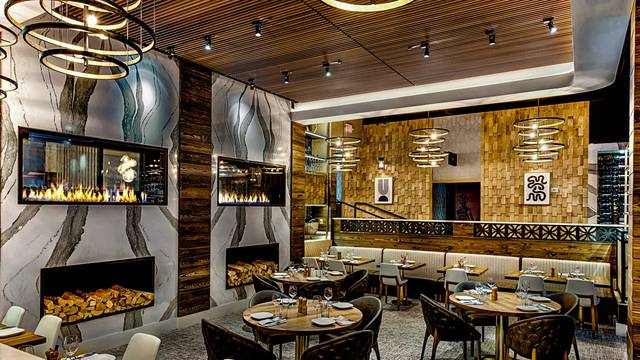Best Ambiance Restaurants Islamabad: Perfect Destinations for a Memorable Meal
Best Ambiance Restaurants Islamabad: Perfect Destinations for a Memorable Meal
Blog Article
Savor Authentic Eastern Cuisine With a Pan-Asian Spin for a Culinary Adventure
Getting started on a culinary trip with authentic Oriental cuisine, improved with a Pan-Asian spin, provides a distinct chance to check out the rich tapestry of flavors that specify the area's varied culinary customs. As you consider these luring recipes, take into consideration the social narratives and historical impacts that form them, each bite providing a story waiting to be found. Instagrammable restaurants Islamabad.

Checking Out Pan-Asian Tastes
In the realm of global gastronomy, Pan-Asian food sticks out for its amazing diversity and the unified interplay of tastes from various Eastern cultures. This cooking method commemorates the unique components and rich practices found throughout the continent, developing a tapestry of tastes that is both appealing and gratifying. Secret to Pan-Asian cuisine is its capability to stabilize different flavors-- pleasant, salted, spicy, and sour-- while highlighting the freshness and high quality of each active ingredient.
From the umami-rich soy sauce of Japan to the intense chili peppers of Thailand, Pan-Asian food offers a substantial scheme of tastes. These components are commonly combined in innovative methods, boosting recipes with layers of complexity. For example, making use of great smelling herbs such as lemongrass and cilantro, common in Vietnamese and Thai food, adds a rejuvenating brightness to recipes, while the incorporation of coconut milk delivers a luscious, rich appearance.
The emphasis on fresh produce and fragrant spices makes certain that each dish is not just a feast for the palate yet also for the senses. Pan-Asian food welcomes diners to start a cooking trip, discovering the large and differed landscapes of Oriental gastronomy with every bite.
Combination Meals to Attempt
While Pan-Asian cuisine is commemorated for its conventional flavors, the modern-day culinary landscape is significantly accepting blend meals that blend these timeless aspects with impacts from various other regions. This innovative approach not only honors the rich heritage of Oriental cooking arts but additionally introduces unique taste experiences that interest contemporary tastes.
An archetype of such a fusion meal is the Korean-Mexican taco, where marinated bulgogi beef is covered in a warm tortilla, covered with kimchi and a zesty gochujang-infused salsa. This combination weds the bold, full-flavored tastes of Korea with the vivid, fresh components of Mexican food. Likewise, sushi burritos have acquired appeal, integrating the fragile creativity of Japanese sushi with the hearty, hand-held convenience of a burrito, frequently featuring blend active ingredients like tempura shrimp and avocado with a drizzle of wasabi mayo.
One more notable recipe is Thai curry ramen, which infuses the creamy, fragrant spices of Thai curry right into the comforting broth of traditional Japanese ramen, producing a harmonious blend that tantalizes the senses. These combination dishes extend beyond simple uniqueness; they represent a cooking discussion in between societies, urging exploration and technology on the planet of Pan-Asian cuisine.
Crucial Components and Flavors
To absolutely value Pan-Asian food, one must comprehend the necessary active ingredients and seasonings that create its foundation. This diverse culinary style attracts from an abundant tapestry of Eastern customs, utilizing an unified mix of structures and flavors. Trick active ingredients consist of soy sauce, fish sauce, and oyster sauce, which give a tasty umami depth necessary to Eastern meals. Complementary to these are rice vinegar and mirin, lending a delicate acidity and sweet taste.
Aromatic elements are crucial, with garlic, ginger, and lemongrass being common throughout various Pan-Asian dishes. These active ingredients give an aromatic base that enhances the intricacy of flavors. Seasonings such as star anise, cardamom, and cinnamon introduce heat and character, echoing impacts from regions like China and India.

Food Preparation Methods and Tips
Mastering the art of Pan-Asian cuisine needs experience with its distinct cooking methods, each adding to the vibrant tapestry of flavors this culinary custom is commemorated for. Central to these methods is the stir-fry, a rapid cooking technique that maintains the dietary honesty and vivid colors of active ingredients. Utilizing a wok, the stir-fry method enables even warmth circulation, important for accomplishing the characteristic structure and flavor equilibrium of Pan-Asian meals.
One more fundamental strategy is steaming, particularly prevalent in Chinese food. This mild method maintains the all-natural tastes and nutrients of active ingredients, making it perfect for seafood and vegetables. Dumplings, a precious staple, often take advantage of steaming, causing soft, delicious structures.
Cooking, additionally important, gives smoky depths to recipes such as Korean bulgogi or Japanese yakitori (Chinese food Islamabad). This method usually entails marinading components, allowing tastes to pass through deeply prior to cooking over an open fire or warmer
Lastly, mastering the art of stabilizing flavors-- sweet, sour, salted, bitter, and umami-- is critical. Effectively layering these aspects can elevate a meal from average to phenomenal, offering a complex and pleasing cooking experience that embodies the significance of Pan-Asian cuisine.
Eating Experiences Worldwide
Around the world, Pan-Asian food offers an exceptional eating experience, celebrated for its abundant tapestry of best restaurants flavors and vivid presentations. This cooking phenomenon has actually transcended social boundaries, catching the hearts and tastes of food enthusiasts worldwide. In worldwide cities like New York, London, and Sydney, Pan-Asian dining establishments act as melting pots where culinary practices from Thailand, Japan, China, and beyond assemble, giving diners with a diverse mix of dishes that highlight the region's variety.
The international appeal of Pan-Asian cuisine exists in its capacity to offer both authenticity and development. Chefs masterfully wed traditional ingredients such as lemongrass, soy sauce, and miso with contemporary techniques, leading to recipes site web that are both acquainted and refreshingly brand-new. This combination enables diners to begin on a culinary trip that values heritage while welcoming modernity.
In addition, eating experiences are boosted via attentively designed environments that show the ethos of Pan-Asian aesthetics. From minimalist Japanese-inspired insides to vivid Thai-themed rooms, each dining establishment offers an unique setting that enhances the cooking offerings. Consequently, clients are not simply taking in a meal yet partaking in a cultural experience, making Pan-Asian dining a truly worldwide sensation.
Conclusion
The exploration of Pan-Asian food supplies an extensive understanding of the complex interaction of flavors and culinary traditions throughout Asia. By welcoming combination dishes such as Thai curry ramen and sushi burritos, the culinary journey not just highlights the versatility of standard ingredients yet additionally showcases ingenious modern strategies. This gastronomic experience, enriched by crucial seasonings and cooking techniques, offers an one-of-a-kind opportunity to value the cultural diversity and cooking creativity that specify Pan-Asian cuisine on a worldwide scale.
Embarking on a culinary trip with authentic Eastern cuisine, improved with a Pan-Asian spin, provides an unique opportunity to discover the rich tapestry of tastes that specify the region's diverse culinary practices.In the realm of worldwide gastronomy, Pan-Asian cuisine stands out for its impressive diversity and the unified interplay of flavors from various Eastern societies. Trick to Pan-Asian food is its capacity to stabilize contrasting tastes-- pleasant, salty, spicy, and sour-- while highlighting the quality and quality of each component.

Report this page